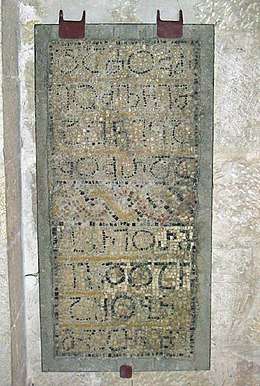Bir el Qutt inscriptions
| Bir el Qutt Georgian inscriptions | |
|---|---|
 Inscription 1 | |
| Material | Mosaic |
| Writing | Georgian language inscriptions written in a Georgian script |
| Created |
AD 430 (inscription 1 & 2) AD 532 (inscription 3) |
| Discovered | 1952 by Virgilio Canio Corbo |
| Present location | Studium Biblicum Franciscanum, Jerusalem |
The Bir el Qutt inscriptions[A] (Georgian: ბირ ელ ყუტის წარწერები) are the Georgian language Byzantine mosaic inscriptions written in the Georgian Asomtavruli script which were excavated at a St. Theodore Georgian monastery in 1952[1] by an Italian archaeologist Virgilio Canio Corbo near Bir el Qutt, in the Judaean Desert, 6 km south-east of Jerusalem and 2 km north of Bethlehem.[2] Georgian inscriptions were found on a mosaic floor.[3][4][5] Two inscriptions are dated AD 430 and the third one AD 532.[6][7]
The monastery where the inscriptions were excavated was founded or rebuilt by the Georgian philosopher and royal prince Peter the Iberian. One of the inscriptions mentions him with his father.[8][9] The other inscription mentions Bacurius the Iberian who is thought to be a possible grandfather of Peter.[10]
So far, the first two carvings are the oldest extant Georgian inscriptions. The inscriptions are kept at the museum of the Studium Biblicum Franciscanum in Jerusalem.[11] Inscription 2 mentioning Peter the Iberian is currently missing.[12]
Inscriptions
Inscription 1
| “ | ႣႠ ႻႭჃႻ ႤႭჃႪႬႨ Ⴋ |
” |
- Translation: "Jesus Christ, have mercy on Bakur and Griormizd and their descendants."
- Dated: AD 430
Inscription 2
| “ | ႼႫႨႣႠႭ ႧႤႭႣႭႰ Ⴄ ႫႠႰ Ⴌ ႣႠ ႡႭჃ |
” |
- Translation: "Saint Theodore, have mercy on Maruan and Burzen, Amen."
- Dated: AD 430
Inscription 3
.jpg)
| “ | ႸႤႼႤႥႬႨႧႠ Ⴕ ჁႱႨႧႠ ႣႠ Ⴋ ႤႭႾႤႡႨႧႠ ႼႫႨႣႨႱႠ ႣႠ Ⴇ ႤჂႱႨႧႠ |
” |
See also
Notes
References
- ↑ Khurtsilava, p. 56
- ↑ Khurtsilava, p. 57
- ↑ Gideon Avni, The Byzantine-Islamic Transition in Palestine: An Archaeological Approach, p. 149, Oxford University Press, 2014
- ↑ Dairat Al-Athar al-Ammah, Annual of the Department of Antiquities, p. 78
- ↑ Michael Avi-Yonah, Ephraim Stern, Encyclopedia of Archaeological Excavations in the Holy Land, V. 3, pp. 879-882
- ↑ Hewitt, p. 4
- ↑ Khurtsilava, p. 58
- ↑ Louis Leloir, Corpus Scriptorum Christianorum Orientalium, p. 71, Secrétariat du Corpus SCO, 1976
- ↑ Glen Warren Bowersock, Peter Brown, Oleg Grabar, Late Antiquity: A Guide to the Postclassical World, p. 466
- ↑ Khurtsilava, p. 59
- ↑ Monachesimo Archived November 9, 2014, at the Wayback Machine. Studium Biblicum Franciscanum
- ↑ Khurtsilava, p. 61
Bibliography
- Hewitt, B.G. (1995). Georgian: A Structural Reference Grammar. John Benjamins Publishing. ISBN 978-90-272-3802-3.
- Khurtsilava, Besik (2016). The inscriptions of the Georgian Monastery in B'ir el-Qutt and their chronology,"Christianity in the Midlle East", No 1,2017, pp. 129-151
- Wachtang Djobadze, Materials for the study of Georgian monasteries in the Western environs of Antioch on the Orontes, Volume 48; Volume 372, Corpussco, 1976
- Georgian Soviet Encyclopedia, Volume. 7, pp. 651-652, Tbilisi, 1984
- Giorgi Tsereteli, The oldest Georgian inscriptions from Palestine, Tbilisi, 1960
- Le Destin de la Géorgie, Revue de Karthvélologie, 1961, p. 115
- Chachanidze, V., Peter the Iberian and the archaeological excavations of Georgian monastery in Jerusalem, Tbilisi, 1977